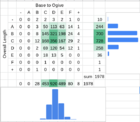@Ammolytics I'm not sure if there is a reference article, per se... but here is my experience.
I'd gotten into pointing and meplat uniforming a little back when the 155.5 Fullbore still dominated FTR. The results that I got always seemed to be a little hit or miss, though. Then, when the 185 Juggernaut was the new hotness for FTR, I was setting up to trim the meplats on a batch of bullets (185s), to be followed by pointing. I measured a handful of bullets (OAL) and came up with an average length of... 1.367", if memory serves. I set the Giraud trimmer to trim to 1.365", and began trimming meplats. Bzzzt, bzzzt, bzzzt, nothing... bzzzt, bzzzt, nothing..., bzzzt. Hmmm... started measuring the ones where nothing was getting trimmed. Yup, they were more like 1.363, 1.361, had a few as short as 1.358". The tips still looked fine, carry on. A few more... bzzzt, bzzzt, bzzzt, then BRRRRZZZZTTT!!! Holy cow what was that? Thought maybe I just caught the edge of the cutter weird when I stuck it in. So I did it again... BRRRZZZZTTT. Okay, what the heck. Measured it, and it was *still* 1.370", even after having a whole bunch hogged off the tip, to where the meplat was well over 0.100"
Ran across a handful more like that, as well as more that were short. I looked at the short ones, with their tiny little meplats (even before pointing), and the long ones, with what looked like the beginning of a wadcutter tip, and thought "there is no flipping way those are going to point up the same". So originally, I started sorting by OAL primarily so I could 'batch' the bullets before meplat uniforming and pointing. With some Skip Otto die shims under the lock ring on the .30 cal insert in my Giraud, it was easy enough to adjust the cut length between batches in a fairly precise manner.
Eventually, I got to thinking, and realized that I really wasn't trying to make any one bullet 'perfect', and there was just enough variation that what was 'perfect' for one sub-lot wasn't going to work on another. What I wanted was to make the BC as uniform as possible. And I was already getting about 95% of that benefit from just sorting by length. Length is a contributing factor to the BC calculation, if I recall...
By the time I was running 200 Hybrids, I was binning into batches of 5 thou... and still seeing 4 or even 5 batches, at that. Somewhere around then, I read a comment by Emil Praslick (formerly of the US AMU) that they (the AMU) sorted their bullets into 3 thou bins, for the same reason - to stratify the BC.
At some point I did run a test, taking the longest bullets from a batch, and the shortest bullets from a batch, and a handful from the middle as a control, and shot them at a 600yd e-target. I don't think I have that plot any more, but it did show pretty clearly that while the groups did overlap considerably, there was a distinct difference in the vertical center of the groups between the long and the short bullets.
The whole process, though, was tedious beyond belief. It got noticeably less miserable - though still not exactly 'fun' - with the advent of the SortEez tool, and then you can get into all sorts of fun stuff like multi-sort - sorting by OAL and BTO at the same time, and end up with really fun graphs like this:

The above is for Berger 200.20X bullets, ranging from <1.500 to <1.521, all the same lot # (D24).
Given that you seem to enjoy the whole data-driven process, I'd strongly suggest you check out getting a SortEez setup. It exports all the data to CSV files, which then can be pulled into either a spreadsheet like I did for mine, or into Python/Pandas or R or whatever your tool of choice is.











